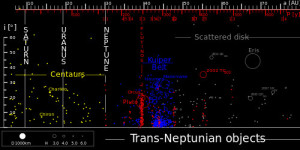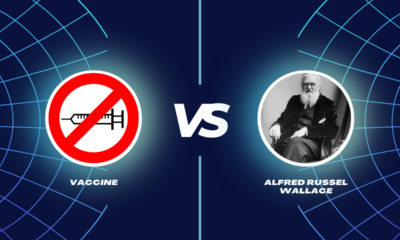Creation Corner
Sedna has company, and lots of it

About ten years ago, astronomers discovered a single dwarf planet, which they named Sedna, beyond any then-known object in the solar system. Its discoverers half suspected it was a freak of nature. It wasn’t, and isn’t. Another astronomical team now reports a new object, a companion to Sedna. They say further this new object won’t be the last such object anyone discovers. But they miss one important implication. Other teams will likely confirm their opinion by discovering a third Sedna, and a fourth, and many more. When that happens, astronomers will have to admit the solar system is significantly heavier than they suppose. And that extra weight, far from supporting their conventional models, undermines them.
A second Sedna
This second Sedna has no name yet. The team under Dr. Chadwick W. Trujillo designate it 2012 VP113. In their letter to the journal Nature, they give its perihelion, or closest approach distance to the Sun: 80 AU. Sedna, at 76 AU, comes somewhat closer. 2012 VP113 measures 450 kilometers across, about half the size of Sedna.
The detection of 2012 VP113 confirms that Sedna is not an isolated object; instead, both bodies may be members of the inner Oort cloud, whose objects could outnumber all other dynamically stable populations in the Solar System.
Trujillo uses the term inner Oort cloud to describe a population of objects between the Kuiper belt (technically from 30 to 50 AU) and the hypothetical outer Oort cloud (the “Oort cloud” of most discourse), beginning at 10,000 AU.
Alicia Chang of the Associated Press interviewed several other astronomers. They included members of the team that discovered Sedna. They agree with Trujillo. Chang quotes David Rabinowitz of Yale University, a co-discover of Sedna:
Sedna is not a freak. We can have confidence that there is a new population to explore.
All this is perfectly true. But Trujillo, Rabinowitz, and others now hailing 2012VP113 all miss this vital point. If an “outer Kuiper belt” exists, with many objects of this size, the Solar system is significantly heavier than astronomers have thought. The added mass then solves one of the few problems for an alternate theory of the origin of comets. According to that theory, comets did not form in a “cloud” waiting for objects inside them to “perturb” them to fall toward the sun. Instead, comets formed from material that launched from earth, from the most violent event the earth has ever known, the one event deserving of the name cataclysm.
Competing theories on comets
Today, the favorite theory on where comets came from, is that they exist in a cloud, 10,000 AU to 50,000 AU from the sun. They originally formed among or near the gas giants. Some of these, passing close to the gas giants, fell into “short period” orbits. Others fell outward, to the present Oort cloud region.
Walter T. Brown, PhD, offers a radically different theory. Comets did not form in any “nursery” among the gas giants. Instead, a subcrustal ocean on Earth broke containment and shot straight up into the air, carrying large amounts of rock and mud with it. Most of this water fell back to earth, and this is the water of the Global Flood. But at least one percent of the earth’s mass stayed in space, and accreted to form the comets, asteroids, and meteoroids we know today.
Brown has always acknowledged one problem with his theory. The Solar System has a large population of comets with aphelia (farthest distances from the sun) of up to 50,000 AU. That, of course, is the outer limit of the Oort cloud. By conventional estimates of the size of the solar system, these comets should have periods (“years”) of about 4 million years. Yet the theory depends on a violent event happening about 5300 years ago.
Brown has always suspected the Solar System has more mass than the total catalogued amount. He also suspected astronomers would find this extra mass beyond the Kuiper Belt. Here’s why: orbiting mass beyond any one object exerts no pull on that object. But once the object moves beyond that mass, it is now subject to the cumulative pull of that extra mass and everything else inside it. So an object could achieve an aphelion of 50,000 AU, yet have a resultant period far shorter than 4 million years. With enough mass, such a comet could have a resultant period well shorter than the 5300 years that elapsed since the Global Flood.
And now, conventional astronomers report they have every reason to find this mass, about where Brown said they would.
Brown cites Iorio’s 2007 paper, showing how heavy the Kuiper Belt must be:
There are at least 70,000 Trans-Neptunian Objects (TNOs) with diameters larger than 100 km in the 30-50 AU region.
And now, Trujillo and Rabinowitz eagerly wait for their colleagues to discover other, equally heavy objects, beyond 50 AU.
In other news: a ringed Centaur
Sedna’s new companion wasn’t the only big news to break in the journal Nature. Braga-Ribas and company reported finding rings around another object, 10199 Chariklo.
Chariklo is a centaur, a satellite of the Sun, between Jupiter and Neptune, that has some of the qualities of an asteroid, and some of a comet. Chariklo is the largest of that class of objects. So if any centaur would have a ring system, Chariklo would.
But: how could Chariklo, or any object that small, have rings?
Brown discussed the problem with this Examiner this morning:
Astronomers used to scoff at the idea that asteroids could have moons. When the first astronomer reported seeing one asteroid orbiting another, his colleagues at first laughed at him.
They aren’t laughing now. But they ignore this key fact: orbital capture cannot take place without something to slow down the object to be captured. That something, says brown, was water vapor.
During the Global Flood, a lot of the water that escaped into space simply evaporated. It persisted as a gas. That was enough to slow down small objects, so that larger objects could capture them.
He also said those objects could never form unless all the material was falling together.
Brown confidently predicted the discovery of more centaurs with rings, and asteroids and Kuiper Belt objects with moons. More to the point, he welcomes the eventual discovery of more companions for Sedna, enough to solve the riddle of how a comet, forming from matter launched from earth, could itself launch into an orbit carrying it to 50,000 AU and maybe beyond. That solution would make the Oort cloud unnecessary.
Reprinted from examiner.com
Update, March 28, 2014: Dr. Walt Brown reminded this correspondent today of a passage in his book that addresses the aphelion of long-period comets:
The distance (50,000 AU) is in error. Comets more than about 12 AU from the Sun cannot be seen, so both the distances they have fallen and their orbital periods must be calculated from the small portions of their orbits that can be observed. Both calculations are extremely sensitive to the mass of the solar system. If this mass has been underestimated by as little as about 17 parts in 10,000 (about the mass of two Jupiters), the true distance would be 585 AU and the period only 5,000 years.
[subscribe2]
Terry A. Hurlbut has been a student of politics, philosophy, and science for more than 35 years. He is a graduate of Yale College and has served as a physician-level laboratory administrator in a 250-bed community hospital. He also is a serious student of the Bible, is conversant in its two primary original languages, and has followed the creation-science movement closely since 1993.
-

 Executive4 days ago
Executive4 days agoSecret Service chief gets no solace
-

 Civilization5 days ago
Civilization5 days agoBiden drops out of race
-

 Executive2 days ago
Executive2 days agoWaste of the Day: Louisville Taxpayers Pay Nearly $600,000 For Empty Building’s Maintenance, Security
-

 Guest Columns4 days ago
Guest Columns4 days agoFear Itself: Democrats’ Favorite Strategy Caused Their Current Chaos
-

 Executive3 days ago
Executive3 days agoWhere is Joe Biden – or Jill?
-

 Executive1 day ago
Executive1 day agoWaste of the Day: Throwback Thursday: Cities Used Crime Prevention Funds on Soccer Games, Paper Shredding
-

 Civilization4 days ago
Civilization4 days agoBuild Iron Dome in the United States To Prepare for Israel’s Worst Day
-

 Executive2 days ago
Executive2 days agoFacile and politically motivated suggestions
















[…] from examiner.com and Conservative News and […]
Vicki Strickler liked this on Facebook.
[…] Sedna has company, and lots of it […]
“When that happens, astronomers will have to admit the solar system is significantly heavier than they suppose.”
Hardly. In fact astronomers already know of hundreds of trans-Neptunian objects big enough to be classed as dwarf planets, of which Sedna is far from the largest. Between them they add up to a tiny fraction of 1% of the solar system’s mass. The estimated 70,000 large-ish TNOs you mentioned probably have a combined mass less than that of Earth.
“orbiting mass beyond any one object exerts no pull on that object”
Er, yes, it does. All objects exert gravitational force on all other objects.
Not on average. Not when one object is in an orbit farther from the primary than the other.
“Not on average. Not when one object is in an orbit farther from the primary than the other.”
No, really, EVERY object is exerting a gravitational force on EVERY other object.
Except that when the other object is ahead of the object one day, a little to the side another, further to the side the day after that, and one of these years it’s behind the object, everything cancels out over the entire period. That is, until the object in question passes beyond the second object’s orbit. Then the second object is always behind, and the pull is always in the same direction: back.
“everything cancels out over the entire period”
Yes, and over any given period your car’s average velocity adds up to zero, because it always ends up parked in your driveway. That doesn’t mean it doesn’t move.
Irrelevant. What’s relevant is that the period of a comet is cut short as it gets beyond the orbits of ever more objects, hence more mass.
“Irrelevant. What’s relevant is that the period of a comet is cut short as it gets beyond the orbits of ever more objects, hence more mass.”
When these objects are lined up such that they don’t pull the comet outward, but instead pull it inward, you mean? That’s true, as far as it goes. The orbiting objects each pull the comet toward themselves at all times; sometimes that pull is more-or-less in line with the pull of the Sun, sometimes it’s orthogonal to the Sun’s pull, and sometimes it is opposite to the pull of the Sun. The Sun pulls a lot harder than anybody else, mind you.
“Except that when the other object is ahead of the object one day, a little to the side another, further to the side the day after that, and one of these years it’s behind the object, everything cancels out over the entire period. That is, until the object in question passes beyond the second object’s orbit. Then the second object is always behind, and the pull is always in the same direction: back.”
No. Let’s use the Sun-Earth-Jupiter system as our model. Every time Jupiter and the Sun are in opposition from Earth’s POV (so the alignment is S-E-J), Earth feels a force outward (or a lessening of the net force inward toward the Sun if you prefer). Every time the Sun and Jupiter are in conjunction from Earth’s POV (so the alignment is J-S-E) the Earth feels an increased inward force, _but the magnitude of the inward force increase is smaller than the magnitude of the outward force increase from the earlier opposition._ This is because gravity is an inverse square force, so the pull from Jupiter when it is on the far side of the Sun is much weaker than the pull of Jupiter when it is on the same side of the Sun and therefore closer. The result over a single Earth orbit is a net force in the outward direction.
Now, it is true that over many, many, Earth orbits there will be many points at which Jupiter and the Sun are at opposition, and the orientation of that alignment against the background stars will slowly change from one alignment to the next. Also, the distance between Earth and Jupiter at opposition varies because of the orbital eccentricities of each planet. Therefore the magnitude of the force on Earth from Jupiter is variable from pass to pass, and direction of the outward force that Earth feels every time it passes inside Jupiter will, over many orbits, walk around in a complete circle. But this is not true over a single orbit, or a handful of orbits. If we were in resonance with Jupiter, then we would get a nudge outward in the same direction repeatedly, which over time would work to change our orbit (see Kirkwood gaps in the asteroid belt).
_If_ this is the effect that you are relying on (gradual precession of the alignment of the opposition) to make the claim that ‘everything cancels out over the period’ – I don’t think that it is, but I’ll be generous in my interpretation – then you have to account for the fact that the same effect applies to the outer body being tugged inward by the intermediate body. So if Earth feels no net outward force from Jupiter over many orbits, then Jupiter feels no net inward force from Earth over many orbits. But that doesn’t jibe with your claim that the pull on the outer object ” is always in the same direction: back”. How can one always pull the other back without in return always being pulled out? Equal and opposite, and all that?
Over a single orbit, of course, there is a net force that is felt in a particular direction – roughly in the direction of the outer planet at the point of opposition (opposition being sun-inner object – outer object). If the approach at opposition is close enough, that force can be quite large and can alter the orbits of one or both objects significantly, depending on their relative masses.
Apply that to a comet now. The comet is attracted to the barycenter of the solar system, because that’s where the sum of all the force vectors from the Sun and all the various planets, moons, etc. points to. Those individual force vectors are always changing, though, in both direction and magnitude. The force vector pointed toward the Sun dwarfs all the others in magnitude, but those other force vectors don’t disappear suddenly when the comet passes inside the orbits of the various planets: those force vectors persist even when the comet is between the planet and the Sun – they now oppose the Sun’s pull to some extent. If the comet passes close enough, that planetary pull can be significant.
From your other statements though it seems as though that you think that one planet (or comet) orbiting closer to the Sun than the other feels no force from that outer planet, either momentarily or averaged over a complete orbit. It has been pointed out to you before that this is not true. The only mass distribution that this would apply to is a hollow spherical shell of uniform density, with the ‘comet/planet/test mass’ inside. A ring, disk, torus, or isolated point masses like planets do not act that way. A toroidal distribution or ring will pull objects _away_ from the axis of the torus/ring towards its inner curvature. Dr. Brown seems to understand this, so I have to assume that the misunderstanding is yours. See
link to mathpages.com
Objects above or below a ring, disk, or torus are drawn down toward the plane of the ring. See
link to youtube.com or
link to galileo.phys.virginia.edu
Returning to Dr. Brown, his efforts to show that a comet with a (conventionally calculated) aphelion of 50,000 AU and period of ~4,000,000 years _could_ have a ‘true’ aphelion of just 585 AU and a period of 5000 years under his model make so many unfounded leaps as to be worthless. Remember that he’s proposing a ring or shell of mass beyond Neptune that is sufficient to slingshot long-period comets back to the inner solar system without affecting the orbits of the outer planets.
To begin with, he uses the formula for the energy per unit mass of an elliptical orbit. However, the shape of the orbit that would be produced by a comet passing through a spherical shell of matter around the Solar System (or some other distribution) would not be elliptical. The mass ‘seen’ by the comet would be a function of time/position on the orbit rather than a constant, M (strictly speaking, M1+M2 but here M1>>>>M2). As a result, to keep the total energy of the orbit the same, the instantaneous calculated semimajor axis, a, would be a function of time/position on the orbit. So the orbit would be noneliptical – more of an egg shape with one sharp end and one blunt end – but the exact shape would depend on the exact mass distribution around the outer solar system. A disk or torus there would behave differently than a hollow spherical shell, warping the orbit in different ways. One could not predict the ‘real’ shape of such an orbit, including the aphelion distance, without knowing the details of this mass distribution. Suffice it to say that the energy of such an orbit could not be described as -GM/2a. It would be tricky to show that such orbits could even be stable.
Second, Dr. Brown states that a comet with a period of 5,000 years (number chosen to make it fit the Flood date) has an aphelion of 585 AU. This is derived, I wager, from Kepler’s third law that the period squared in years is equal to the semimajor axis cubed in AU. For earth, 1 year^2 = 1 AU^3. Thus 5000yr^2 = 292.4AU^3, so aphelion =2(292.4) = 585 AU. This would be true for an elliptical orbit in which M and a are constants, but as we have seen the comet’s orbit in Dr. Brown’s model is very much nonelliptical. There is no simple equation that will tell you what the aphelion of a noneliptical orbit with a given period is. To know that you would need to know the mass distribution, which isn’t specified. But it won’t be true that P^2=a^3.
Dr. Brown then shows that an elliptical orbit with an aphelion of 50,000 AU would have the same energy as an elliptical orbit with an aphelion of 584 AU if the Solar System was 1.0017 times heavier than believed. That doesn’t seem so bad; it’s about a Jupiter-worth of unknown mass, but it does have to be present at the barycenter for the math to work – it has to act over the entire orbit, not just over the outermost parts. The whole calculation would make sense if he were merely arguing that the mass of the central solar system has been underestimated by about eight times the current uncertainty, and that 4 million year period comets are actually 5 thousand year period comets traveling along standard elliptical orbits. That’s a tough sell, since it doesn’t fit with all the other experimental data and observations we have about the visible solar system, and it seems even Dr. Brown doesn’t believe that that is the case. So why bother to derive that 1.0017 number at all? Dr. Brown uses an equation that does not hold in his model, and plugs in some numbers calculated from other equations that do not hold in his model, and reports a mass number that is not applicable to his model. Let’s be clear: if his model is true, then the orbital energy equation for very long period comets is wrong, but he uses it. Also, if his model is true, the aphelion calculation for long period comets is invalid, but he uses that as well. The result demands ~1 Jupiter mass more in the central solar system. Ignoring that result, he then argues that trans-Neptunian mass is responsible: mass that has no effect on the solar system out to beyond Pluto (except for when it does, like his claim that it explains the Pioneer anomaly which was first noticed at the orbit of Saturn, but is too weak anyway), but which does affect things that go out farther (except for when it doesn’t, like the lack of an effect on the Voyagers out at ~120 AU, where the effect should have been building for some time). But the only hint about math to back up _this_ claim as opposed to the excess-mass-in-the-sun claim is this footnote: “In November 2005, Jon Schoenfield showed that if the mass is spherically distributed 40 AU or more from the Sun, the required extra mass would exceed 70 Jupiters. It is much more likely that the mass is distributed as a hoop or torus. If so, the extra mass is much smaller than 70 Jupiters.” Caculations not shown. In his model, there are somewhere between 2 and 70 Jupiter-masses of material between 40 and 600 AU from the Sun, distributed something like a hoop, torus, or sphere (not specified). What is also not shown, tellingly, is exactly how this theorized mass produces the effects that he claims – the 5000 year period instead of a 4,000,000 year period, for example. I’ll wait to find his theory credible until he can show how this math works out for multiple objects, like Eris out at 96 AU or Sedna out at ~90 AU, or the Voyagers or Pluto or the long-period comets.
Hey, this has been fun. I’ve gotten to brush up on my astronomy again.
“What’s relevant is that the period of a comet is cut short as it gets beyond the orbits of ever more objects”
Nope. Orbits don’t matter much. A comet could get beyond the orbit of Jupiter, but if Jupiter happened to be on the opposite side of the Sun at the time, so what? The planet would have less gravitational influence on the comet than a nearby gnat would. Gravitational force is determined by mass and distance, not the radius of orbits.
Your argument now assumes Jupiter would keep station on the far side of the sun from the comet at all times. The period of Jupiter is slightly less than twelve years. A comet’s period is typically longer than that. So Jupiter spends half its time closer to the comet than the Sun is.
Mathematically, the effective mass of the primary in any system having more than one object in orbit is the sum of the masses of the actual primary and of every other object having an orbit that spends its time inside the orbit of the object in question. But you insist on treating the Solar System as an n-body problem. That’s hardly necessary when the Sun so vastly outweighs any one object in orbit around it.
“Mathematically, the effective mass of the primary in any system having more than one object in orbit is the sum of the masses of the actual primary and of every other object having an orbit that spends its time inside the orbit of the object in question. But you insist on treating the Solar System as an n-body problem. That’s hardly necessary when the Sun so vastly outweighs any one object in orbit around it.”
You already know that’s not true. If the Solar System didn’t represent an n-body problem when calculating cometary orbits (or planetary orbits for that matter) there would be no conflict between osculating orbits and ‘real’ orbits, as you called them in your June 30, 2013 post on Flood dates. The astronomers who back-calculated the position of comets Halley and Swift-Tuttle would not have needed to do stepwise integration of the gravitational influence of all the planets in order to make their calculations. But the Solar System _is_ an n-body problem. Even though the Sun vastly outweighs any other single object in the Solar System, a close flyby of a planet can produce a significant force that changes a comet’s orbit. The effect on the comet’s orbit depends on the geometry of the interaction. That’s why planetary interactions have to be accounted for. The mass of Jupiter pulls on the mass of a comet constantly, and always and forever in the direction of Jupiter (and vice versa). Jupiter’s mass does not ‘pretend’ to be at the center of the Sun when the comet is far away and then turn off somehow when the comet is closer to the Sun than Jupiter is, and then turn back on but pretend to be at the center of the Sun again when the comet moves farther out.
You already know that Jupiter has Lagrange points. Jupiter’s L2 point, about a third of an AU sunward from Jupiter, is where the magnitude of the gravity of the Sun and Jupiter are equal but pulling in opposite directions (roughly speaking). Get closer to Jupiter than that, and Jupiter’s gravity is stronger than the Sun’s.
You know that the existence and location of Neptune were predicted on the basis of irregularities in the orbit of Uranus. Uranus is always inside the orbit of Neptune, so how in your cosmology is Uranus’ orbit perturbed by an outer body like Neptune? In the real world, Uranus is acted upon by Neptune, just as a comet would be acted on by masses farther out from the Sun than it.
None of the above shows that comets would not have a much shorter period, and aphelion, once we show more objects in the outer reaches of the solar system than everyone thought existed.
We deal here with averages, and with the key orbital elements of period and aphelion. The evidence now militates against the last objection to an earthly origin for cometary material.